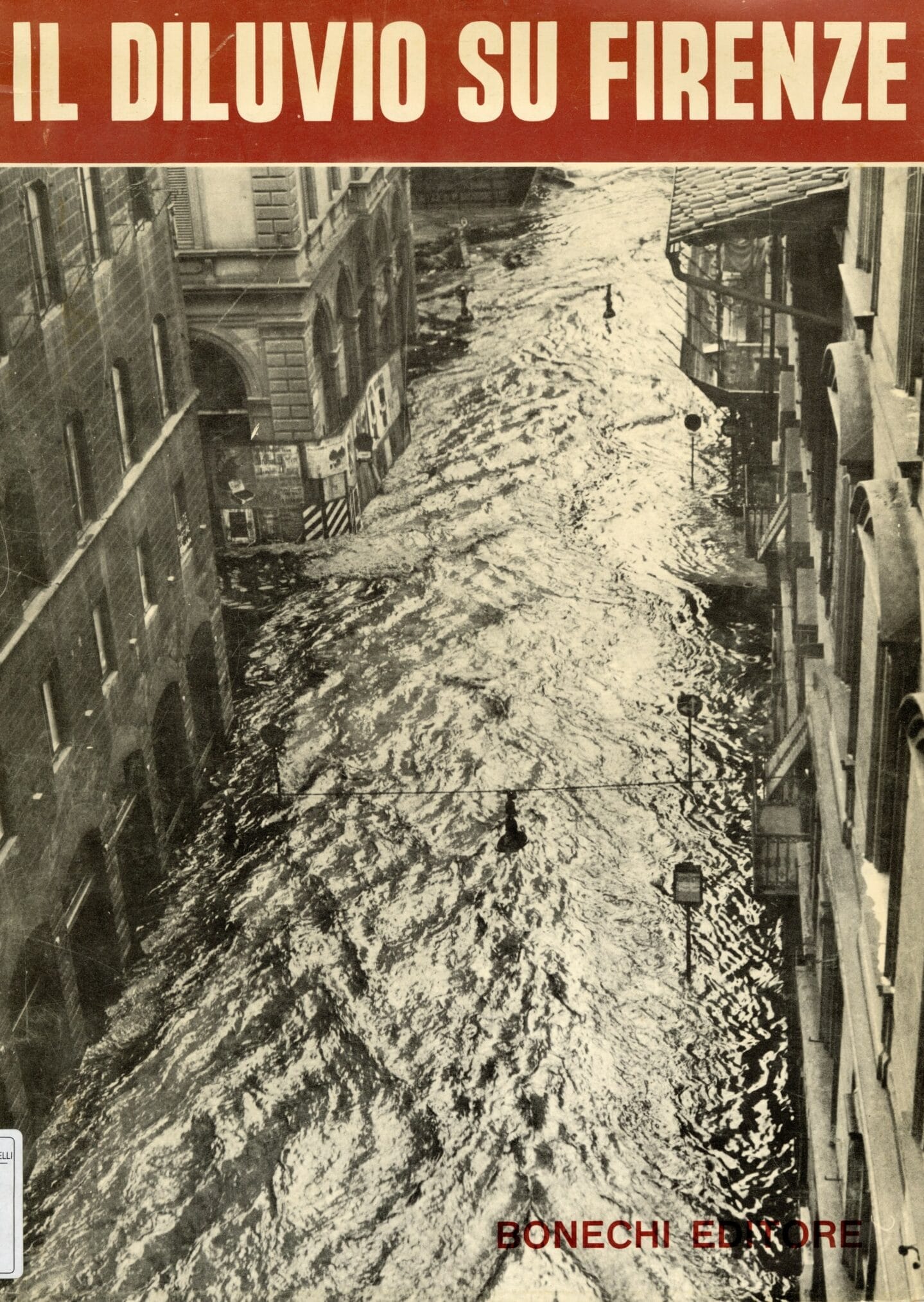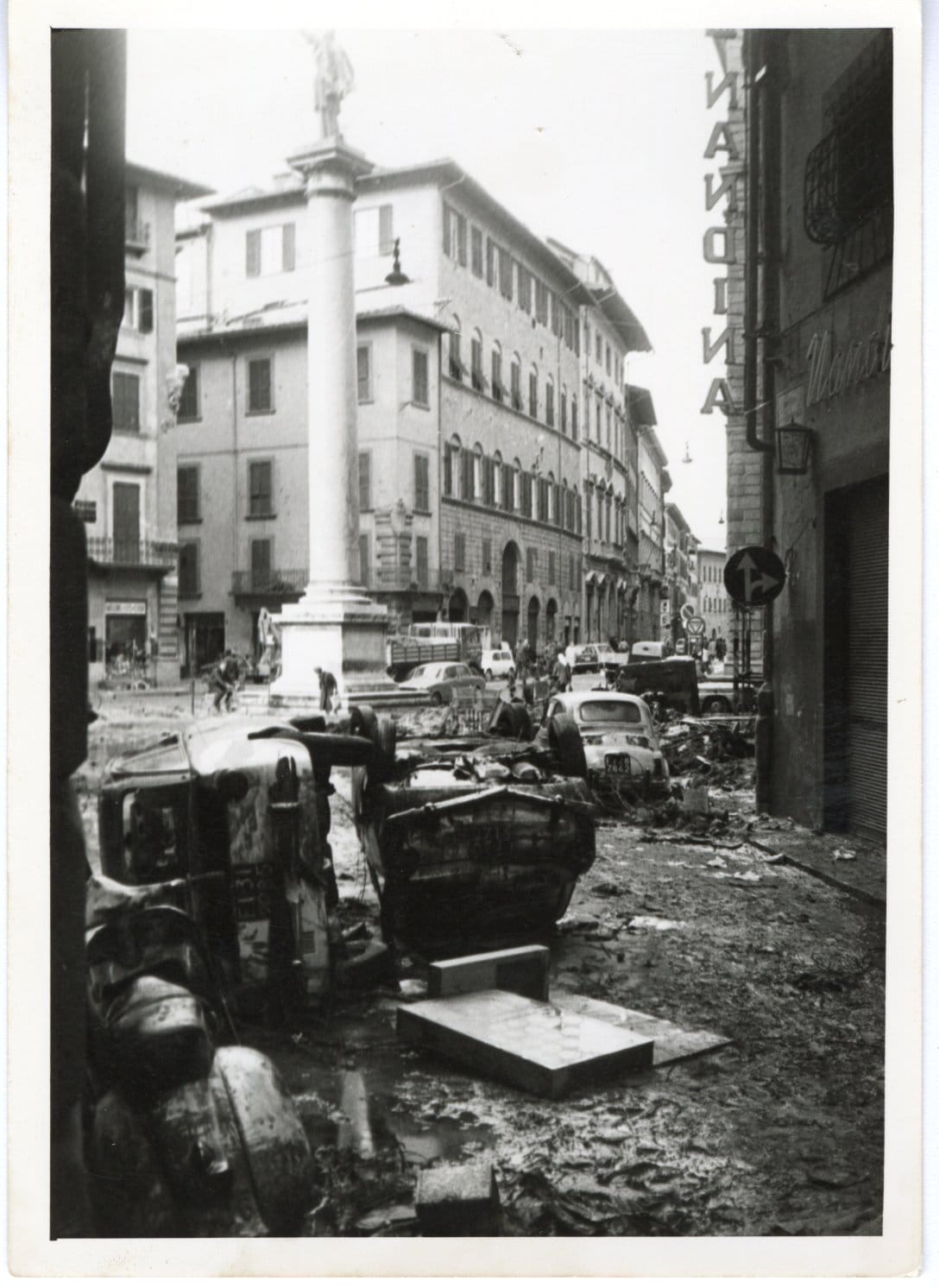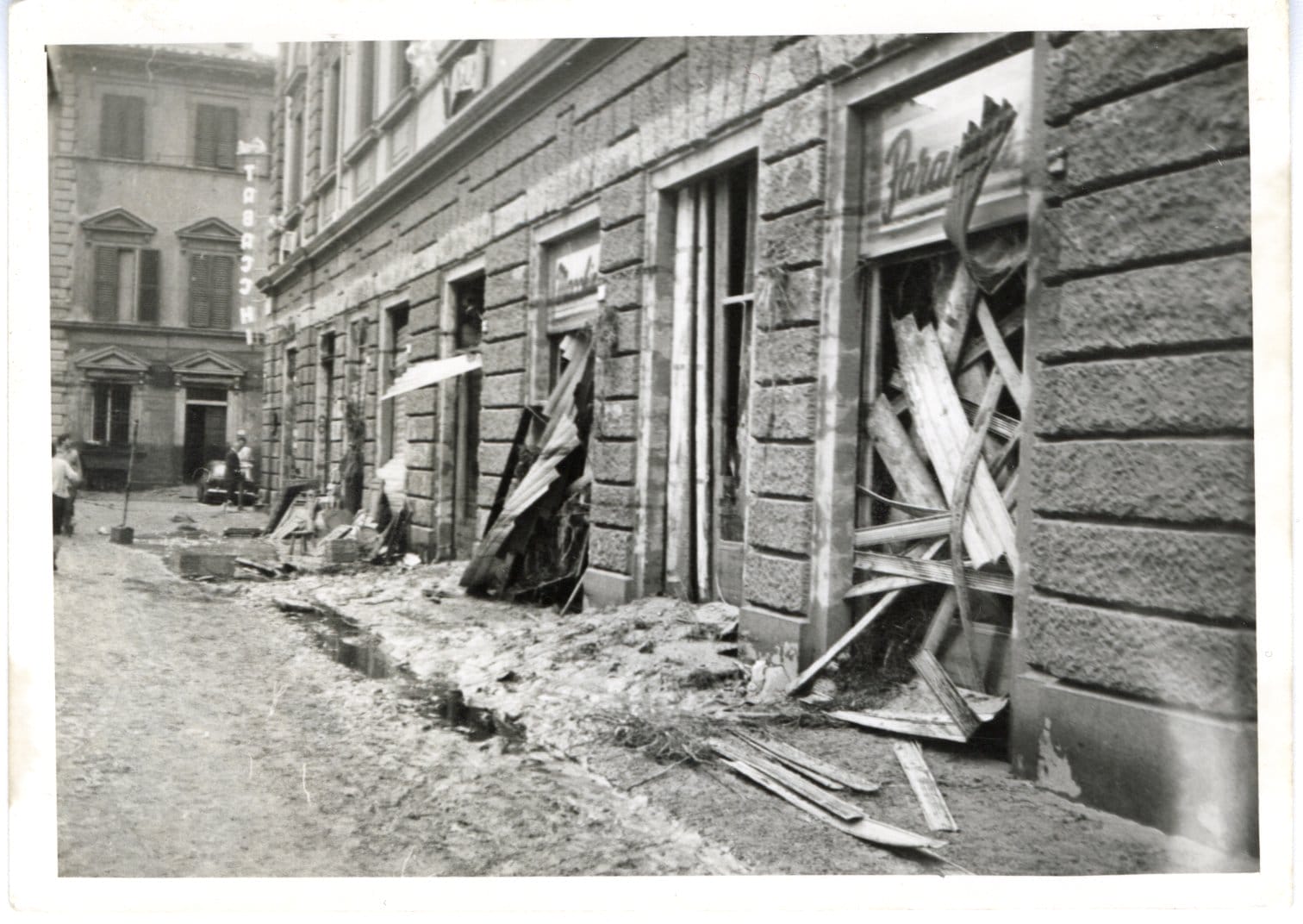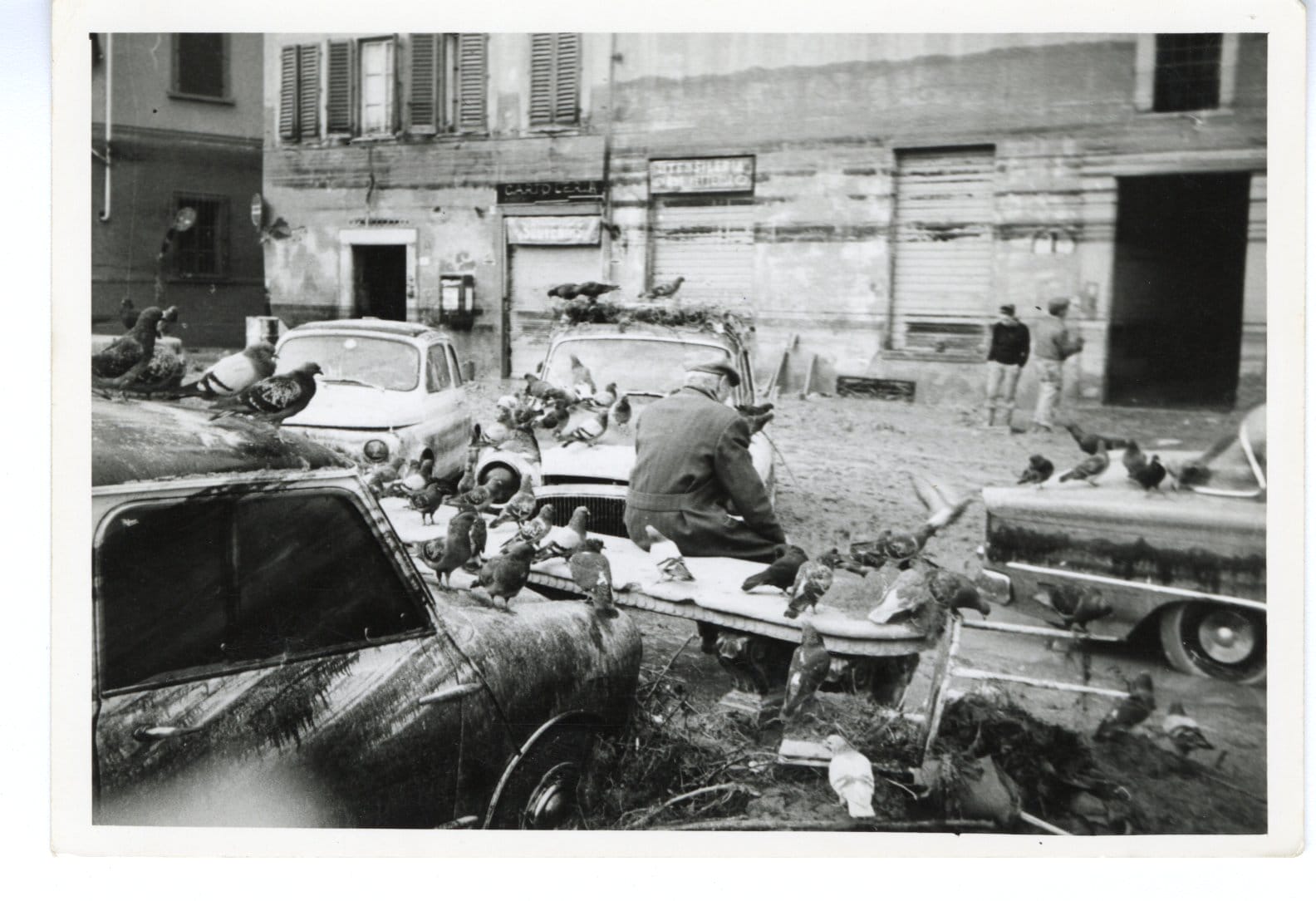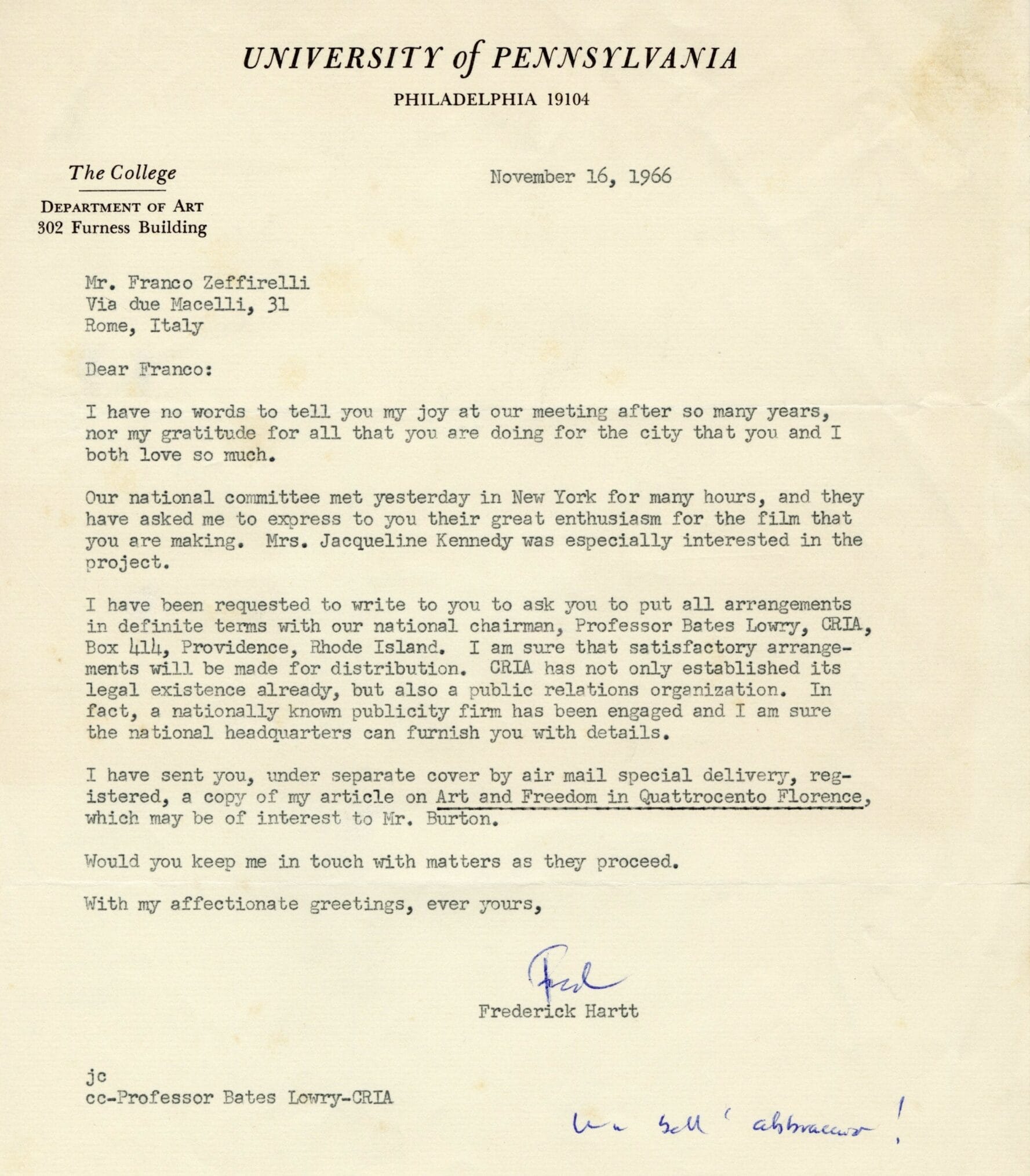“It was six in the morning on 4 November 1966 when my sister Fanny called me at home to say she was a virtual prisoner in her house because the Arno had burst its banks and Florence was flooded – a cathastrophe of apocalyptic proportions. I tried to calm her as best I could, then dressed and drove to Florence at once to see what I could do.
The flood was still in full spate when I arrived, with cars crashing down sidestreets and wave upon wave of water forcing its way over the barricades. I realized at once that it would be possible to film it, either as a record or more positively as a way of showing the outside world what was happening to the city so that we could raise
help.”
Franco Zeffirelli, Zeffirelli – An autobiography, Weidenfeld & Nicolson
Zeffirelli leaves Rome on the morning of November 4th, and drives to Florence.
Although the main streets are closed because of the flood, he manages to arrive in Florence making a wide detour, avoiding the valley of the Arno and approaching the city from from the higher ground to the north. He then documents the disaster with hundreds of photographs. Shortly after, with a crew from the italian national broadcasting corporation, he realizes the documentary Per Firenze, aimed at raising funds from all over the world.
Zeffirelli leaves Rome on the morning of November 4th, and drives to Florence.
Although the main streets are closed because of the flood, he manages to arrive in Florence making a wide detour, avoiding the valley of the Arno and approaching the city from from the higher ground to the north. He then documents the disaster with hundreds of photographs.
Shortly after, with a crew from the italian national broadcasting corporation, he realizes the documentary Per Firenze, aimed at raising funds from all over the world.
Zeffirelli leaves Rome on the morning of November 4th, and drives to Florence.
Although the main streets are closed because of the flood, he manages to arrive in Florence making a wide detour, avoiding the valley of the Arno and approaching the city from from the higher ground to the north.
He then documents the disaster with hundreds of photographs.
Shortly after, with a crew from the italian national broadcasting corporation, he realizes the documentary Per Firenze, aimed at raising funds from all over the world.
Zeffirelli leaves Rome on the morning of November 4th, and drives to Florence.
Although the main streets are closed because of the flood, he manages to arrive in Florence making a wide detour, avoiding the valley of the Arno and approaching the city from from the higher ground to the north.
He then documents the disaster with hundreds of photographs.
Shortly after, with a crew from the italian national broadcasting corporation, he realizes the documentary Per Firenze, aimed at raising funds from all over the world.
8.
Titolo:
Images of the flood Sotto la fotografia:
Via Magliabechi.
november 1966
Zeffirelli leaves Rome on the morning of November 4th, and drives to Florence.
Although the main streets are closed because of the flood, he manages to arrive in Florence making a wide detour, avoiding the valley of the Arno and approaching the city from from the higher ground to the north.
He then documents the disaster with hundreds of photographs.
Shortly after, with a crew from the italian national broadcasting corporation, he realizes the documentary Per Firenze, aimed at raising funds from all over the world.
Zeffirelli leaves Rome on the morning of November 4th, and drives to Florence.
Although the main streets are closed because of the flood, he manages to arrive in Florence making a wide detour, avoiding the valley of the Arno and approaching the city from from the higher ground to the north.
He then documents the disaster with hundreds of photographs.
Shortly after, with a crew from the italian national broadcasting corporation, he realizes the documentary Per Firenze, aimed at raising funds from all over the world.
Zeffirelli leaves Rome on the morning of November 4th, and drives to Florence.
Although the main streets are closed because of the flood, he manages to arrive in Florence making a wide detour, avoiding the valley of the Arno and approaching the city from from the higher ground to the north.
He then documents the disaster with hundreds of photographs.
Shortly after, with a crew from the italian national broadcasting corporation, he realizes the documentary Per Firenze, aimed at raising funds from all over the world.
Zeffirelli leaves Rome on the morning of November 4th, and drives to Florence.
Although the main streets are closed because of the flood, he manages to arrive in Florence making a wide detour, avoiding the valley of the Arno and approaching the city from from the higher ground to the north.
He then documents the disaster with hundreds of photographs.
Shortly after, with a crew from the italian national broadcasting corporation, he realizes the documentary Per Firenze, aimed at raising funds from all over the world.
Today the Complesso di San Firenze houses the Fondazione Franco Zeffirelli.
Zeffirelli and Richard Burton about to record the commentary for the documentary Per Firenze.
Burton, who had just starred in the movie The taming of the shrew directed by Zeffirelli, had asked if there was anything he could do to help Florence: so he becomes the narrator in the documentary, both in the English and in the Italian versions.
Although originally intended to be distributed only abroad, the documentary Per Firenze is first broadcasted in Italy by the national television corporation on 23 November.
Headlines of the reviews on Rome’s newspaper “Paese Sera” and Florence’s “La Nazione”.
24 november 1966 Dear Ziffirilli, maybe only in our Bargellini family you are still called like this, in memory of the times when you studied Architecture and a southern professor used to mistake your name.
In those days, according to my nephew and your pal Enrico Freyrie, your were the “clever Ziffirilli”.
Now, according to me, you are the “most clever Zeffirelli”!
Even if the items on the agenda were terrible, yesterday night I wrapped the Council’s meeting at 8 pm to allow everybody to see your documentary.
You have perfectly pictured the Florentines’ deep fierceness, the river’s onslaught, the humilation of the mud.
The actor is excellent.
Do thank him in the name of the city; and thanks also to you, in haste, but with plenty of gratitude.
Piero Bargellini
Born in Boston in 1914, Frederick Hartt was an Italian Renaissance scholar.
During World War II was an officer in the Monuments, Fine Arts, and Archives program of the US Army, and from 1944 was particularly active in the reconstruction of Florence.
He also organized the structure of the “Monuments Men” in Italy, which allowed for the cataloging of all artistic and monumental assets, up to the recovery of works looted by the Third Reich.
Professor of Art History in several U.S.
Universities, in November 1966 he left temporarily his engagement with University of Pennsylvania to go back to Florence in order to help the population after the flood.
He was then among the promoters of CRIA – Commitee to Rescue Italian Art, with the aim of raising funds for the recovery of Florence.
He was also made an honorary citizen of Florence.
Hartt died in Washington, D.C., in 1991.
He is buried in Florence, in the Cimitero delle Porte Sante.
A charity evening is organized in London, where actors and musicians perform works related to Italy, and independent TV companies record the event for future transmission.
The program features also scenes from Shakespeare plays staged in London by Zeffirelli: Much Ado about Nothing with and Robert Stephens, Romeo and Juliet with Judi Dench and John Stride.
